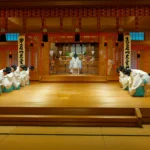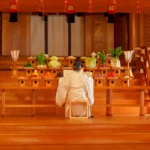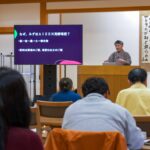from the “Oomoto International” (Apr.-Jun.1987)
By Masamichi Tanaka
It is a universal phenomenon that the death of a human being causes fear among the living, and grief for the bereaved family. The balancing of these contradictory sentiments love for the deceased and fear of the corpse may be the primary factor in the formation of certain folkways. Fear of departed souls differs among various cultures. In general, foraging peoples and hunting peoples have more of such fear than a more settled agrarian population. In particular, people ceaselessly goaded by hunger in the severe physical environment of barren areas or of the Arctic circle have a special dread of departed souls. On the other hand, agricultural communities and stock-farming peoples in Africa, and agricultural societies in Southeast Asia and on the Pacific coast believe in the life after death and venerate their ancestors.
In Japan, people believe that after a certain period of time, departed souls transcend the impurities of death and join the spirits of their progenitors. They are identified with the spirituality of the rice and grains, or with the god of the fields who descends from the mountains to the plains in spring to supervise the cultivation of the land, and then after the harvest, returns to the mountains to become a mountain god.
For the preparation of the New Year celebration, in some regions, villagers cut pine trees in the mountains and bring them home. They raise special altars for the departed at home in front of the pine tree, and make various offerings. All the family and relatives gather and pay homage to their forebears and prepare a feast. Also, it is a common custom to put up decoration pine trees at the front gate to celebrate the new year.
In the summertime, too, people honor their ancestors. To welcome the spirits, villagers mow the grass and tidy up the paths from the tombs to their houses. They pick wild flowers in the mountains and decorate the altar with them, believing that the ancestors come along with the flowers. They also make bonfires to usher in the family spirits. As at New Year’s, all the family and relatives worship the ancestors together and celebrate by feasting. After the service, once again they set bonfires to see the ancestors off. The famous Daimonji bonfire in Kyoto, and a charming festival where lantern boats are carried off by the current in a stream, also symbolize the seeing off of the ancestral spirits.
All over Japan, because of these festivals, New Year’s and mid-August are the worst times to travel. Families in cities return to their hometowns and airlines, railways, boats and highways are all jampacked. Thus, most people manage to have a vacation at New Year’s and in Mid-August, which they spend with their relatives. In every town and village, community folk dancing takes place in mid-August. People sing local folk songs and beat drums while young and old dance around a central platform.
Two other occasions involving the ancestors fall on the spring and autumn equinox, with people visiting family graves and offering flowers and delicacies, while at home they perform the rituals.
Buddhism was introduced into Japan in 538 A. D. through China and Korea. Since then Buddhism has assimilated Japanese folk culture to a large extent, and many rites which originated in Japanese folk belief are found in the Buddhist ceremonies of today.
Shinto, the Way of the Gods, or the indigenous religion of Japan, has observed such rites from time immemorial.
In Oomoto, the formal observance of the ancestors began around 1900. In 1912, a worship hall for the spirits of the ancestors was built, and since that time grand festivals for the ancestors have been celebrated on the day succeeding the spring and autumn grand festivals.
In the Mirokuden Sanctuary in Ayabe, to the left of the main altar of the Creator of the Universe, stands an altar for ancestral spirits. Oomoto followers enshrine their ancestors at this altar in the Mirokuden and in their own household shrines. In the morning and evening services, followers also offer prayers for the ancestors. On the occasion of the monthly ceremony, similar rites are observed. Anniversaries of the passings take place both in Ayabe and at the homes of the followers.
On May 5, the day of the Grand Festival of Miroku or the Spring Grand Festival, and on November 6, the day of the Autumn Grand Festival in commemoration of the Foundress Nao Deguchi, the grand festivals for the ancestors take place in the Mirokuden Sanctuary.
In Oomoto these ceremonial observances for the spirits of the dead are not acts of propitiation. Their aim is to solace the ancestral spirits. It is a comfort and a progress to such spirits that their descendants are virtuous, and by acts of faith and by their prayers cause the spirits themselves to evolve. It is a part of God’s plan for the salvation of the souls of the departed in order to brighten the spiritual world itself.



